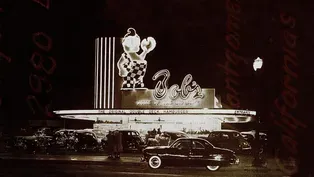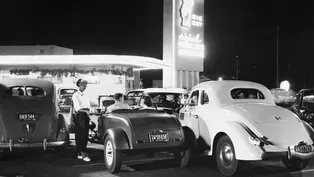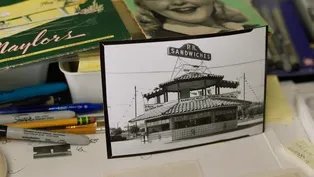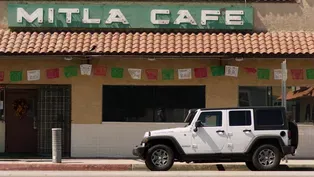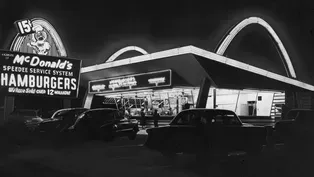
Secrets of In-N-Out History
Clip: Season 6 Episode 1 | 5m 22sVideo has Closed Captions
In-N-Out's first burger stand on Route 66 may have given birth to today's drive-thru.
In-N-Out is a beloved and iconic chain steeped in fast food lore. Lost LA host Nathan Masters shares a meal with L.A. Times journalist Stacy Perman to talk about its birthplace, located on Route 66 in the San Gabriel Valley city of Baldwin Park, California. Discover how its humble beginnings as a burger stand on a tiny plot of land led to an invention that influenced modern-day drive-thrus.
Problems with Closed Captions? Closed Captioning Feedback
Problems with Closed Captions? Closed Captioning Feedback
Lost LA is a local public television program presented by PBS SoCal

Secrets of In-N-Out History
Clip: Season 6 Episode 1 | 5m 22sVideo has Closed Captions
In-N-Out is a beloved and iconic chain steeped in fast food lore. Lost LA host Nathan Masters shares a meal with L.A. Times journalist Stacy Perman to talk about its birthplace, located on Route 66 in the San Gabriel Valley city of Baldwin Park, California. Discover how its humble beginnings as a burger stand on a tiny plot of land led to an invention that influenced modern-day drive-thrus.
Problems with Closed Captions? Closed Captioning Feedback
How to Watch Lost LA
Lost LA is available to stream on pbs.org and the free PBS App, available on iPhone, Apple TV, Android TV, Android smartphones, Amazon Fire TV, Amazon Fire Tablet, Roku, Samsung Smart TV, and Vizio.
Providing Support for PBS.org
Learn Moreabout PBS online sponsorshipCruise west down Route 66 from Mitla Cafe and you'll arrive in the San Gabriel Valley suburb of Baldwin Park, home to another place steeped in fast-food lore.
It was here back in 1948 that Harry and Esther Snyder opened a modest burger stand that eventually grew into a cherished local chain.
But In-N-Out didn't just win the hearts of Southern Californians.
It revolutionized fast food with a stroke of genius-- the two-way drive-thru speaker, making traditional carhops and walk-up windows relics of the past.
Today, this company, still family-owned, is famously guarded, but that didn't stop "L.A. Times" journalist Stacy Perman from unwrapping its story in her 2009 book.
Stacy and I grabbed some In-N-Out to go for a chat--where else?-- in the front seat of my Jeep.
So, Stacy, you wrote, like, the book about In-N-Out.
Perman: I did.
Masters: And, I mean, they're a famously private, some would say secretive, company.
That must have been a challenge writing about a company that keeps to itself.
Perman: You have this chain, this beloved chain that everybody in--not just Southern California but literally the world knows, as I found, but they knew nothing about it, because they're so private.
It was a fascinating challenge to kind of go down this rabbit hole and just learn about this history and its influence on Southern California fast food and beyond.
Masters: Why do you think In-N-Out is so beloved?
Perman: In large part, it's because it's family-owned.
They didn't go corporate.
They refuse to franchise or go public.
They've stayed the same.
The menu--the burger that you're eating is the same burger that you could've eaten when Truman was president.
You go inside, you think you've ben transported to post-war Southern California.
Masters: So, In-N-Out, the name describes the concept that back in the forties and fifties was quite revolutionary.
Perman: When Harry and Esther Snyder, the founding couple of In-N-Out Burger, moved to Baldwin Park, they had no money.
They got this little triangular spit of land, so, they couldn't kind of replicate the style of the time.
But Harry was a ingenious guy and he was a ham radio enthusiast and a kind of amateur engineer, and he rigged up this two-way radio system.
He said, "OK, someone will drive up, they'll order through this little radio, and then drive through and out."
And that's how it got the name In-N-Out.
A lot of people were confused.
They would send their sons out to help them figure out how to actually order.
Masters: It's funny because what you're describing is a experience that's so common to most Americans, going through the drive-thru, but at the time, it was a novelty.
Perman: No one had seen it before.
It was, like, high technology.
It was kind of the starting point for the modern-day fast-food restaurant.
The funny thing is, is Harry never took out a patent on the device.
Masters: Oh.
Perman: This time in America, you know, things had changed.
Women were part of the workforce.
People were on the go and busy.
So, the kind of sit-down dinner was changing, and the highway system meant that people could go from Point A to Point Z in the space of a few hours.
So, eating on the go became pretty vogue.
Masters: They give you the option, and probably they did back then, too, of whether you want to eat it in the car, and they'll put it in a little box like this for you, right, or put it in a bag and you bring it home.
Perman: Correct.
Masters: Yeah.
I've never noticed that at another fast-food chain.
Perman: I--thinking about that, I think you're right.
Yeah.
Masters: Now, the In-N-Out story is also linked to that of another fast-food chain, Carl's Jr.?
Perman: Yes.
Carl Karcher was younger than the Snyders but he was kind of the elder statesman of what was fast food then.
He was one of the pioneers.
So, by the time Harry and Esther were about to start In-N-Out, they sought him out.
They met and they became, actually, lifelong friends.
He gave them advice and the advice was always focus on the product and the personal touch, and never give up.
These are kind of really kind of old-timey, simple philosophies, but they worked, and the Snyders took them to heart.
Masters: In the early days of fast food, if you walked into a different--like, a Carl's Jr. or a McDonald's, was it common to see squeaky-clean aesthetics, the smiling faces?
Perman: I think it was, because they were really all mom and pop.
So, there was a real, like, skin in the game.
This was your place.
It wasn't this franchise, faceless, nameless, corporate America.
Masters: Which is what all the other fast-food chains have become, unfortunately.
But In-N-Out's managed to keep that alive.
Perman: Well, it goes back to Harry's philosophy, which was keep it simple, do one thing, and do it well, which is why the menu has 4 items.
They didn't add Happy Meals or specials.
There are no movie tie-ins.
Masters: It's funny that something that is really so conservative can also seem so radical today.
Perman: Yeah.
In terms of both fast food and corporate America, they really run counterintuitively, and yet they're wildly successful and profitable.
It didn't hurt the bottom line.
Masters: So, when you were writing and researching the book, you must've had a lot of In-N-Out.
[Laughs] Perman: More than I care to admit, yes.
That's where I got some really great stories of people who would tell me, like, the lengths they would go to for an In-N-Out, since there's so few of them.
There were stories of flying them to, you know, Minnesota for someone's birthday.
I will say I do feel like I taste history when I bite into a burger.
Masters: That's, again, a big part of what they're selling.
They're selling history and nostalgia.
Fast Food and Car Culture (Preview)
Video has Closed Captions
Iconic fast-food chains from McDonald’s to Taco Bell were born in SoCal. (30s)
Double Burgers and Classic Cars at Bob's Big Boy
Video has Closed Captions
Double hamburgers, Googie architecture and classic cars at Bob's Big Boy in Burbank, CA. (3m 31s)
Roadside Architecture Evolved With Car Culture
Video has Closed Captions
Attention-grabbing, eye-catching designs turned architecture into roadside advertising. (3m 21s)
Taco Bell's Fast Food Origin Story
Video has Closed Captions
Taco Bell and Del Taco can trace their fast food origins to Mitla Café in San Bernardino. (5m 52s)
How McDonald's Revolutionized Fast Food Burgers
Video has Closed Captions
McDonald's evolved from a car-hop drive-in in San Bernardino to a global fast food giant. (5m 4s)
Providing Support for PBS.org
Learn Moreabout PBS online sponsorshipLost LA is a local public television program presented by PBS SoCal
